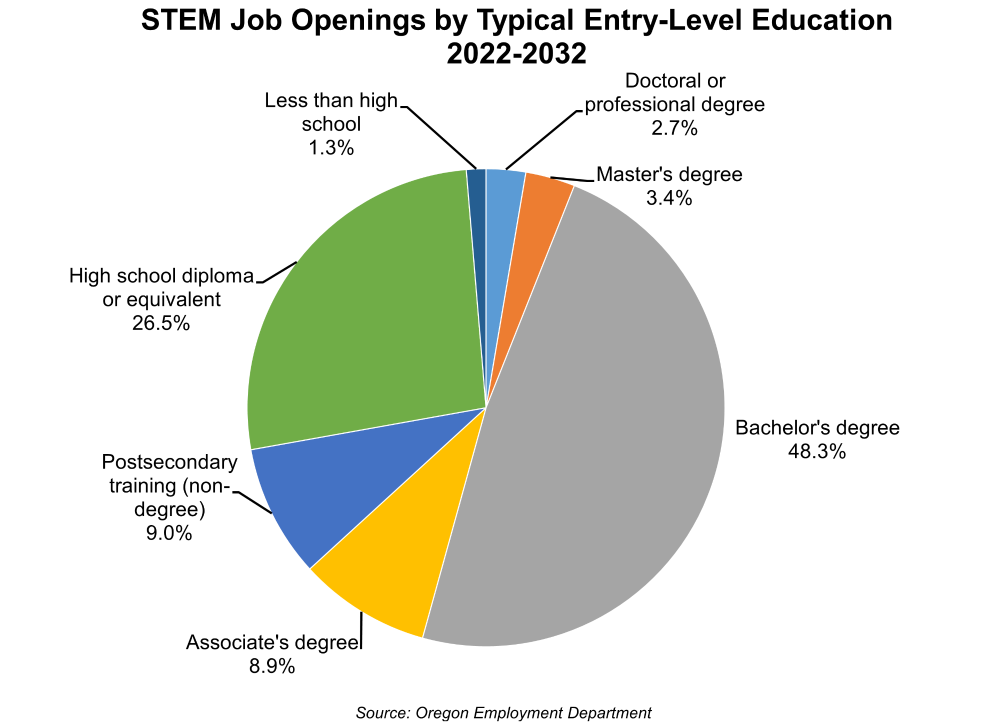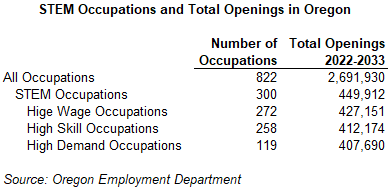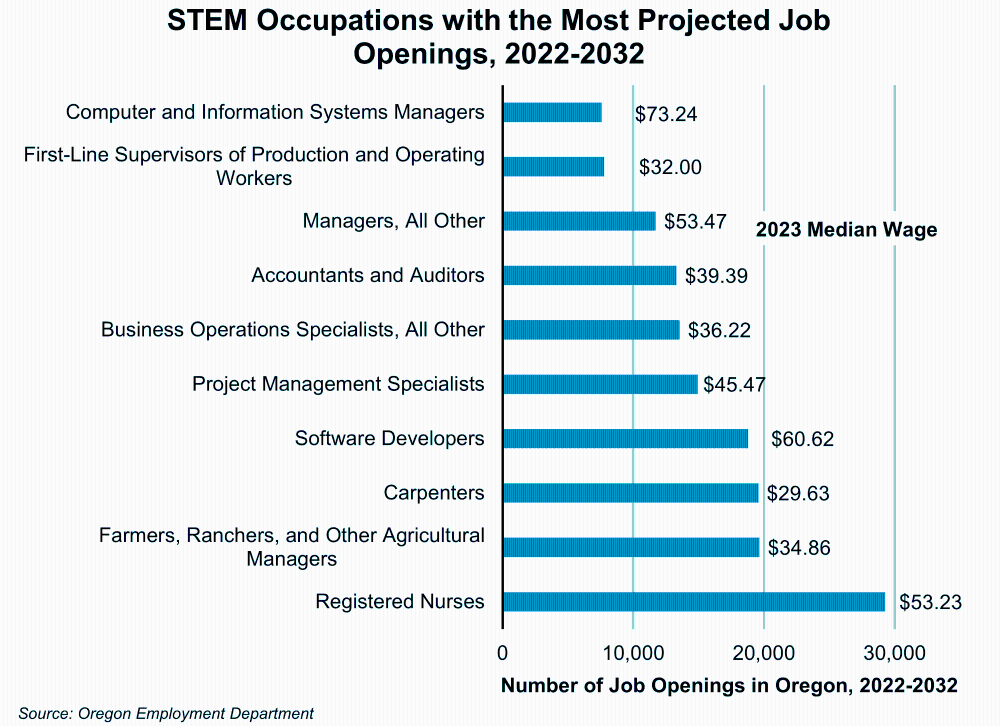10-Year Occupational Projections for STEM Jobs
February 22, 2024STEM jobs are an important part of Oregon’s workforce. With over 490,000 STEM jobs in Oregon, STEM careers make up a sizeable share of Oregon’s labor force and projected jobs in the future.
Chances are, you have heard the term STEM (Science, Technology, Engineering, Mathematics), but exactly what is a STEM job? Several definitions exist. While all are focused on science, technology, engineering, and mathematics, some include health care jobs and even jobs related to the arts. This article and the Career Explorer Tool on QualityInfo.org use the Brookings Institute’s definition of a STEM occupation.
According to the Brookings Institute, a STEM occupation requires a high level of knowledge in one or more core STEM fields. The selection of STEM occupations is based on information from the U.S. Department of Labor’s O*NET (Occupational Information Network Data Collection Program). O*NET collects detailed surveys of workers in every occupation. These surveys gather data that assess the knowledge level required to perform the workers’ current job. Based on the surveys’ responses, O*NET assigns a knowledge score for each occupation. The Brookings Institute used the knowledge scores to identify STEM occupations. Out of the occupations tracked by the Oregon Employment Department, 300 are STEM occupations based on the think tank’s definition.
STEM is not a passing fad. This acronym has been, and will be, around for a long time. Why? Because it represents a group of occupations that many see as key to our economic well-being. You can read about STEM on Wikipedia and on social media. There are STEM blogs, newsletters, and Twitter accounts, programs, coalitions, and initiatives, all geared toward educating the world about STEM and educating individuals for STEM careers. There is no doubt, current and future demand exists for people with a STEM-related education.
Education and STEM
Want a STEM job? If so, attaining a postsecondary education may improve your chances. Most STEM jobs require education and training to learn the skills and knowledge for the job. The typical entry-level education for almost 72% of STEM job openings is postsecondary training or higher. Nearly half (48%) of STEM job openings require a bachelor’s degree.

Looking at all projected job openings in Oregon, 74% of openings that require a doctoral or professional degree are STEM jobs. Forty-eight percent of openings that require a bachelor’s degree and 60% that require an associate’s degree are STEM jobs.
Physicians, pharmacists, and physical therapists lead the way among the doctoral or professional degree STEM jobs. At the master’s degree level, nurse practitioners and postsecondary teachers in health specialties account for the largest number of STEM jobs. At the bachelor’s degree level, registered nurses, software developers, and project management specialists dominate STEM jobs. Construction managers, biological technicians, as well as dental hygienists lead the way among the associate degree jobs.
Will We Have Enough?
One reason you may have heard the term STEM is due to the ongoing discussion and concern about whether there will be enough graduates with STEM skills to meet the demand. This becomes an even more important discussion for sectors that are more dependent on STEM skills. For instance, about 55% of jobs in the information sector are considered to be STEM jobs. With such a large share of jobs being STEM, there is an enormous overlap in filling information jobs and filling STEM jobs.
Education planners and policy makers are working to assure an adequate supply of workers is available to meet the need – not an easy task given the various factors that impact both supply and demand. Oregon STEM Hubs around the state work with education, industry, and community organizations to foster the development of STEM skills and interest in STEM career fields. Efforts like these will help build a foundation of awareness and understanding that students can carry with them through school and well into joining the workforce.
Employment and Wages
Health care practitioners and technicians, computer and management occupations, and construction occupations dominate the expected job openings during the next decade among STEM jobs, but trained workers will be in demand in all areas.
Nearly 450,000 job openings in STEM careers are projected between 2022 and 2032. The growth rate for STEM jobs during this period is 13%, outpacing the growth rate for all occupations (10.4%). Only 15 STEM occupations are expected to see an employment decline during the decade.
The Oregon Employment Department categorizes occupations as paying a high-wage, being in high-demand, or requiring high-skill. Most STEM occupations are high wage or high skill, and 119 occupations are high-demand occupations. A total of 101 STEM occupations are high wage, high skill, and high demand.

While there is an investment of time and money in education for most STEM career fields, STEM occupations generally pay well. Over 270 STEM occupations are considered to pay more than Oregon’s median wage for all occupations ($23.75 per hour) in 2023.

You can view the relationship between employment and wages of STEM occupations in our Career Explorer Tool.
Summary
STEM jobs are here to stay. And they play a vital role in the Oregon economy today and will continue to be important into the future. While STEM jobs tend to require higher levels of education, they also tend to pay well, and the demand is high due to growth as well as the need to replace retiring workers.